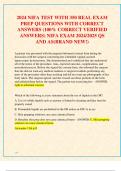2024 NIFA TEST WITH 350 REAL EXAM
PREP QUESTIONS WITH CORRECT
ANSWERS (100% CORRECT VERIFIED
ANSWERS) NIFA EXAM 2024/2025 QS
AND AS(BRAND NEW!)
A patient was presented with the prepared informed consent form during the
discussion with her surgeon concerning her scheduled vaginal-assisted
laparoscopic hysterectomy. She demonstrated and verbalized that she understood
all of the tenets of the procedure, risks, expected outcome, complications, and
procedural process. Before she signed the consent form, she informed the surgeon
that she did not want any medical students or surgical residents performing any
parts of the procedure other than assisting and did not want any photographs of her
body taken. The surgeon agreed, and she crossed out those portions of the form
and initialed them before she signed. The patient was exercising her: - ANSWER-
right to informed consent.
Which of the following is a true statement about the use of liquids in the OR?
A. Use of volitile liquids such as acetone is limited to cleaning and they must be
properly stored
B. Flammable liquids are prohobited in the OR unless an ESU is in use
C. Skin prepping solutions can cause chemical burns
D. Betadine skin prep does not cause chemical burns - ANSWER-C. Skin prepping
solution can cause chemical burns
Alexander 15th p33
pg. 1
,Proper care and handling of surgical specimens is imperative for correct diagnosis,
treatment, and prognosis planning of the patient. Select the response that best
reflects correct specimen care and handling.
A. Label consecutive specimens
B. Send all specimens to the lab together as one pickup, including the frozen
sections
C. Avoid placing specimens for frozen section in formalin
D. Neutralize formalin/formaldehyde spills with glycerin and call the hazmat team.
- ANSWER-C. Avoid placing specimens for frozen section in formalin
Alexander 15th p32
From the following, choose the types of anesthesia that will allow patients to
tolerate potentially uncomfortable procedures while maintaining their own airway
and be easily aroused from light sleep.
A. Moderate anesthesia care
B. Local infiltraion
C. Moderate sedation/analgesia
D. Regional anesthesia - ANSWER-C. Moderate Sedation/analgesia
Alexander 15th P130
Question text
Morris Bettelman, an 86-year-old retired plumber, states that he has suffered from
a groin hernia all of his adult life; he states, "as far back as I can remember."
Sometimes he has to push the bulge back into his abdominal muscle and then he is
fine until he has a coughing spell. This morning the bulge was large and tender
when he woke up and he could not reduce it. As the pain increased, he felt weak
and nauseous. His daughter took him to the emergency department. Morris was
diagnosed with a strangulated incarcerated hernia and scheduled for emergency
surgery. If the contents of Morris' hernia sac become compromised, with
pg. 2
,strangulation of the bowel, the probable label on his surgical specimen will be: -
ANSWER-c. necrotic bowel.
The number one patient safety issue identified in a survey of peri-operative nurses
is preventing: - ANSWER-Wrong site/procedure/patient surgery
Reprocessing (flashing) instruments in the OR is high risk because: - ANSWER-
OR personnel not properly trained to reprocess instruments
To safely transfer and position patients in a manner that prevents shearing,
personnel should use a mechanical lifting device for a supine-to-supine transfer of
a patient weighing more than: - ANSWER-157 lbs
_______________ should be the primary decision makers for what equipment and
supplies are purchased and stocked in the difficult airway management cart. -
ANSWER-Anesthesia personnel
Early on, during the preliminary sponge count on closure of a repair of a ruptured
abdominal aortic aneurysm, the circulating nurse was unable to account for 2 lap
sponges. He had meticulously maintained accountability for all sponges and
instruments discarded from the sterile field and bagged each sponge carefully. He
immediately turned and addressed the entire team in a clear voice. Select the
appropriate communication that the circulating nurse must employ during this
count discrepancy. - ANSWER-"We have a count discrepancy. We started with 70
sponges and find only 68. We are missing 2 lap sponges. Everyone, please check
your areas.
The OR is a danger-prone area for both patients and staff. Providing a safe
environment of care for the patient involves identifying, mitigating, and managing
the hazards inherent in surgical care. Choose the answer below that completes the
blanks in this sentence: The risk of the surgical hazard of _________________ can
pg. 3
, be mitigated through _______________________. - ANSWER-wrong patient,
wrong site, and wrong side surgery; site marking and presurgical checklists
A patient was transferred to the postanesthesia care unit (PACU) by the anesthesia
provider and perioperative nurse. A hand-off report was given, using situation,
background, assessment, recommendation (SBAR) format, to the accepting PACU
nurse. The first element of information that should be presented in the hand-off
report is: - ANSWER-patient identification and procedure performed.
A 47-year-old man was admitted to the emergency department (ED) with
respiratory symptoms, facial and upper body abrasions, burns, and moist lesions
after a small package, delivered to his office, exploded and sprayed him dried
powder and glass shards. In response to the reported mechanism of injury, the ED
team sequestered him in a secluded area away from the rest of the patients. The
team believed that this was highly suspicious of a bio-terrorism event. The
epidemiologist was called, and the patient was transferred to a negative-pressure
isolation room and placed on standard, contact, airborne, and droplet precautions.
Based on these actions, which microorganism agents might be suspected to be
involved? - ANSWER-Anthrax and smallpox
If a staff person receives a needlestick injury, what is the first corrective action? -
ANSWER-Wash wound with soap and water; flush mucous membranes.
Contact with infected patients or infectious material places healthcare workers at
risk for occupational-acquired infection. Which communicable disease are
healthcare workers at risk for acquiring or transmitting? - ANSWER-Seasonal
influenza
Proper specimen management techniques prevent errors and include all of the
following EXCEPT: - ANSWER-Receiving specimens from the surgical field then
affixing patient label to each
pg. 4




